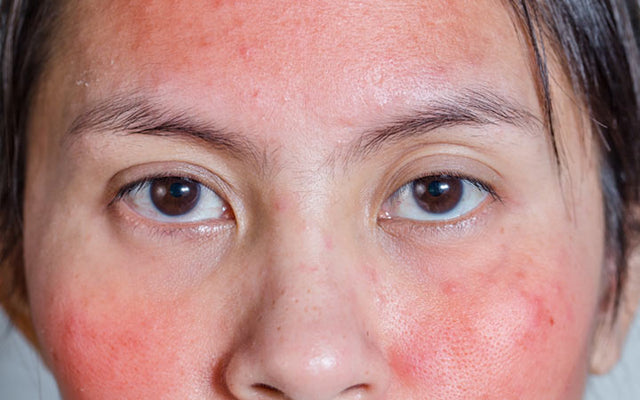Psoriasis which is a chronic condition that causes red scaly patches of skin to develop seborrheic dermatitis which is a skin condition that affects the scalp ringworm which is a fungal skin. This in turn leads to the redness in the places where skin has been burnt.

Facial Rashes What S The Diagnosis Differential Diagnoses Guidelines In Practice
They range from infections bacterial viral or fungal various skin conditions insect bites or stings to environmental factors.

What causes red itchy patches on face. Impetigo a bacterial infection is symptomatic of red sores blisters itching rash and crusting. The contagious form of impetigo is common in children. The common causes include.
When this happens the sun burns skin tissues causing a red patch on the face. Depending on the cause of your itchiness your skin may appear normal red rough or bumpy. The reverse effect is seen when fear is experienced and the skin lightens.
In chickenpox Varicella zoster measles Rubeola virus or German measles Rubella virus itchy. Eczema is a genetic condition where your skin barrier isnt working as well as it should be. This condition is typically associated with silvery white scales on the skin that finally advance into the thick dark pink or red spots and patches.
The sun is the most causative agent of red patches on face. The infectious causes of an itchy skin may include. Seborrheic dermatitis can also affect oily areas of the body such as the face sides of the nose eyebrows ears eyelids and chest.
Caused by bacteria or fungi entering through a crack or cut in the skin red painful swollen skin with or without oozing that spreads quickly hot and tender to the touch fever chills and red. Heat during summers or even hot water can lead to minor burns in the skin. It affects the skin around the nose and mouth.
These appear as red thickened silver plaques that are tenacious. After blistering a red rash that causes itching is seen in children. Childhood viral infections often present with skin rashes that may cause itching in many cases.
Seborrheic dermatitis may go away without treatment. Too cold or too warm weather can also cause red patches in the skin of a person. Red patches on the skin can occur due to a number of reasons.
Causes of Red Spots on Skin There are very many factors that can lead to red spots on your skin. The most common is eczema which usually causes red dry flaky skin. Psoriasis is a chronic skin disorder that can cause itchy dry patches on face scalp neck hands and feet.
The widespread skin issue causes inflammation of the skin that results in a red scaly itchy rashes. From a sunburn to an allergic reaction there are many things that can cause your skin to become red or irritated. Seborrheic seb-o-REE-ik dermatitis is a common skin condition that mainly affects your scalp.
It causes scaly patches red skin and stubborn dandruff. It could occur due to an infection heat allergens or immune system disorders. Seek immediate medical attention once.
Eczema patches most commonly occur in. It may be because extra blood rushes to the skins surface to fight off irritants. During an eczema flare the skin may also be intensely itchy.
Also known as pruritus proo-RIE-tus itchy skin is often caused by dry skin. Psoriasis is a long-term inflammatory skin condition that causes dry patches on the skin. Repeated scratching can cause raised thick areas of skin that might bleed or become infected.
See also Purple Bump on. Although psoriasis can occur anywhere on the skin facial involvement is commonly observed occurring in nearly 50. This article contains the possible causes of red patches on your skin and different treatment options you could use to get rid of the skin condition.
The suns UV lights are strong enough to destroy melanin and other protective skin mechanisms. The reddening of the face in response to a psychological stimulus is perfectly normal and occurs when the bodys sympathetic nervous system causes the small blood vessels close to the surface of the skin to dilate increasing the blood flow to the region. Its common in older adults as skin tends to become drier with age.